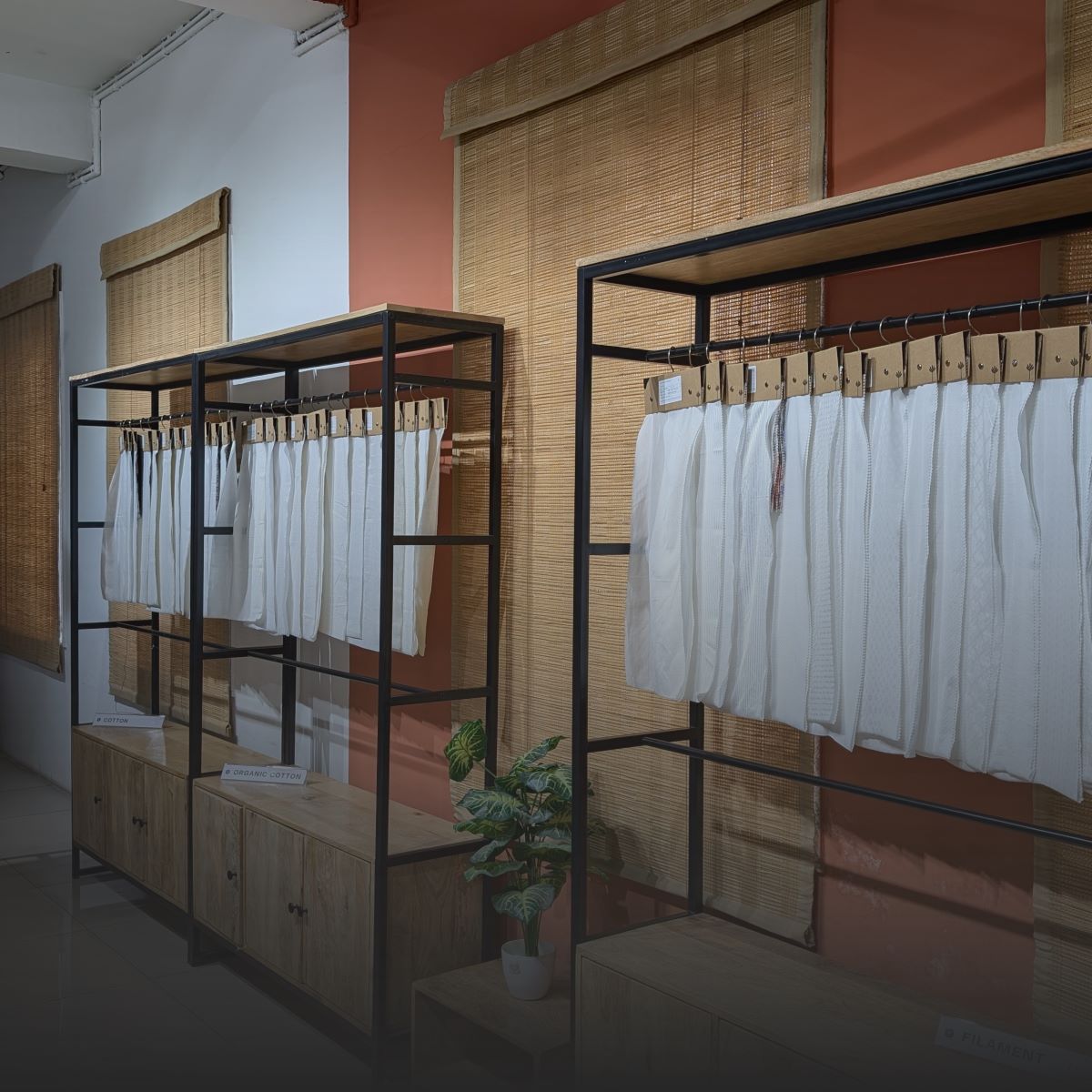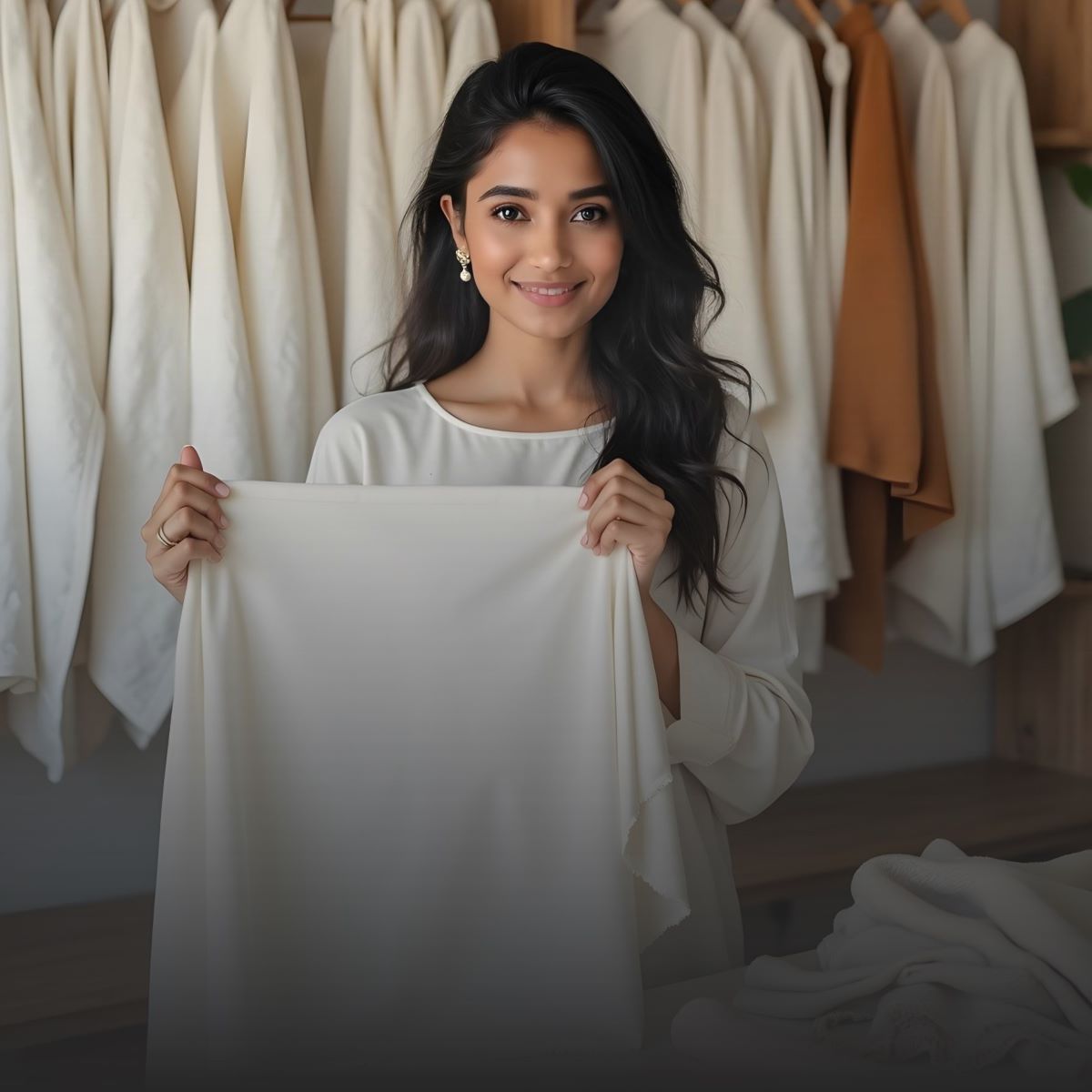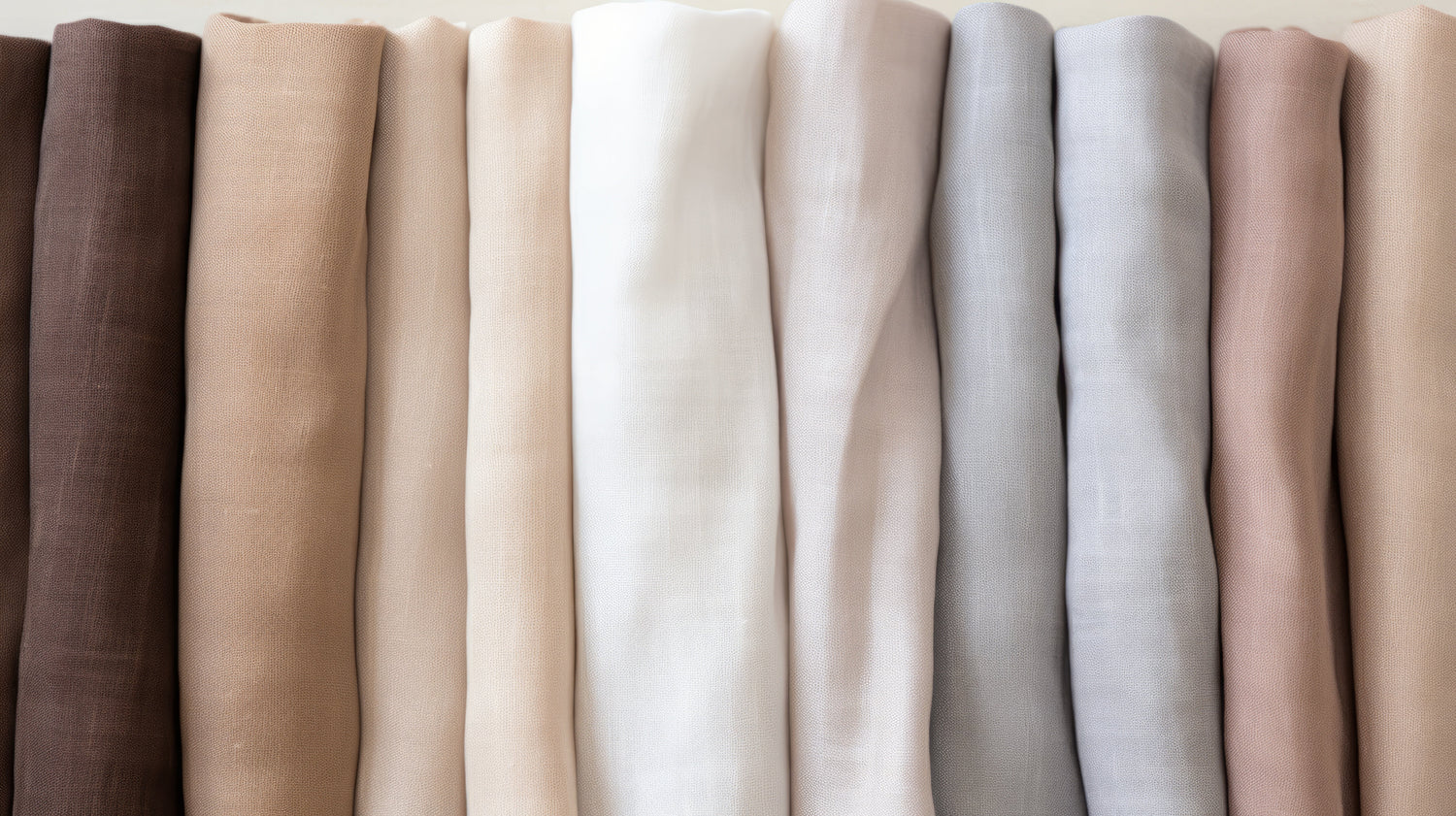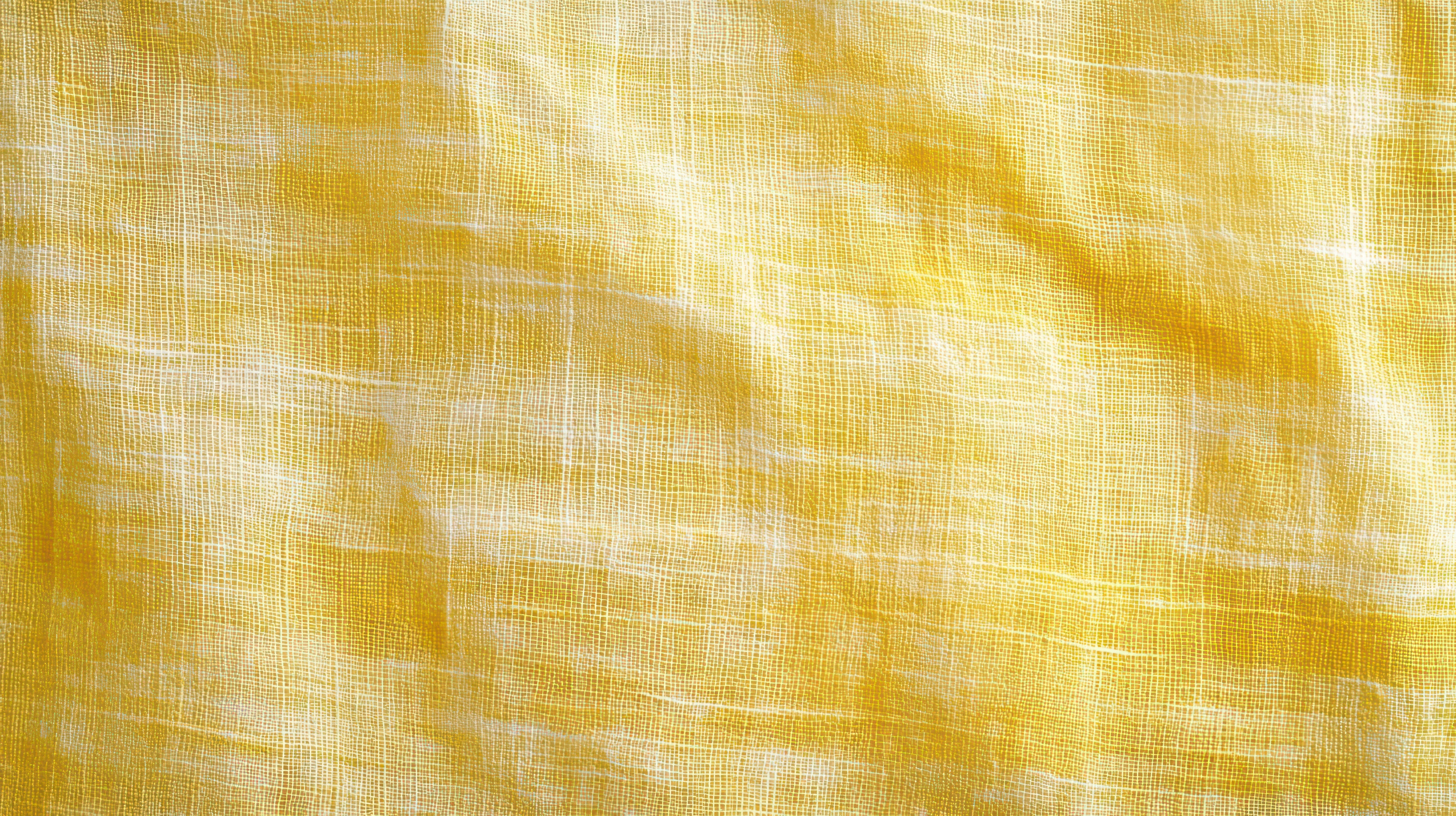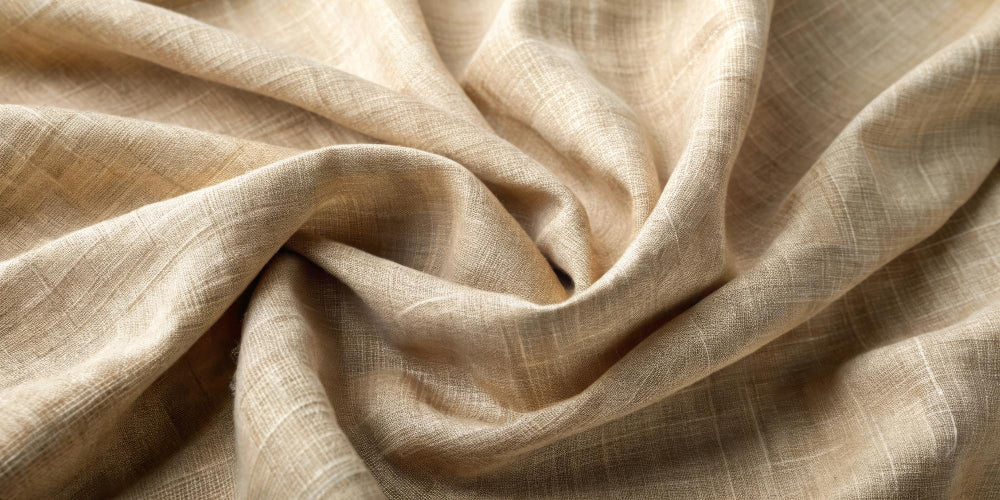Natural fabrics for shirts and trousers are changing the future of fashion by combining style and ecology. Cotton, linen, silk, wool, hemp, LivaTM, LENZINGTM, and BembergTM are some of the materials that are setting new standards for comfort, quality, and being eco-friendly as global brands move towards more ethical sources.
These fabrics are breathable, biodegradable, and timeless, which means they can be used for both regular clothes and designer clothes.
We are looking for natural fabric for shirts & trousers—what options do you have? It is a question that sourcing workers are often asked.
Fabriclore's curated portfolio of 300+ certified natural fabrics is the answer. These textiles make durable, exportable clothing. Discover why natural fabrics are enabling the next generation of eco-friendly clothing.
Understanding Natural Fabrics: Comfort Meets Sustainability
Natural fabrics are clothes that are made from resources that can be used again and again, like plants, animals, or recycled natural fibres. They are the foundation of eco-conscious and circular fashion because they are soft, breathable, and last a long time.
Why Natural Fabrics Matter in Apparel
- Renewable: Sourced from nature—cotton, flax, wool, silk, hemp, and bamboo.
- Biodegradable: Naturally decomposes without leaving microplastic residue.
- Comfortable: Breathable structure maintains airflow and skin comfort.
- Durable: High tensile strength ensures longevity and wash resistance.
- Sustainable: Produced with low energy consumption and minimal environmental footprint.
Synthetics like polyester and nylon speed up fashion, but natural fibres promote slow fashion, which means they balance performance, style, and caring for the environment.
Types of Natural Fabrics Used in Shirts and Trousers
There are three main types of natural fibre fabrics: plant-based, protein-based, and regenerated cellulosic. Here is a quick list of the most important ones that affect how clothes are made around the world:
|
Fabric Type |
Fiber Source |
Common Use |
Key Qualities |
|
Cotton |
Cotton plant |
Shirts, chinos, uniforms |
Soft, breathable, durable |
|
Linen |
Flax plant |
Resort shirts, trousers |
Cool, crisp, moisture-wicking |
|
Wool |
Sheep fleece |
Winter trousers, blazers |
Warm, naturally elastic, odor-resistant |
|
Silk |
Silkworm cocoon |
Premium shirts, linings |
Smooth, lustrous, temperature-regulating |
|
Hemp |
Hemp stalk |
Sustainable shirts & bottoms |
Strong, UV-protective, antibacterial |
|
Bamboo |
Bamboo pulp |
Shirts, casualwear |
Soft, hypoallergenic, moisture-absorbent |
|
Liva™ / LENZING™ / TENCEL™ |
Certified wood pulp |
Fluid shirts, eco-trousers |
Silky drape, breathable, sustainable |
|
Bemberg™ Cupro |
Cotton linters |
Dress shirts, linings |
Silky, anti-static, biodegradable |
|
Organic Cotton |
Certified farms |
Sustainable collections |
Pesticide-free, soft, traceable |
|
Jute & Cotton-Jute Blends |
Jute plant |
Workwear, trousers |
Textured, eco-friendly, durable |
These materials are great for making high-end shirts, casual trousers and resort wear because they are comfortable, well-made and made with care.

Why Choose Natural Fabrics for Shirts and Trousers
Fast fashion is giving way to ethical fashion in the fashion world. This change is being driven by natural fabrics, which are the best mix of comfort, durability, and sustainability.
1. Breathability for Everyday Comfort
Cotton, flax, and hemp all let air flow through their fabrics, which keeps clothes cool and dry. This makes them great for everyday wear in warm places.
2. Skin-Friendly and Hypoallergenic
Being gentle on sensitive skin, organic cotton, bamboo, and BembergTM Cupro make clothes more comfortable to wear.
3. Moisture Regulation
Fibres like LivaTM, LENZINGTM, and TENCELTM are good at wicking away body sweat, so people who wear them stay cool as the weather changes.
4. Easy Dyeing and Tailoring
It is essential for global fashion brands that natural materials absorb dyes evenly so that there is consistent colour accuracy across production runs.
5. Sustainable and Ethical
Natural fibres all break down and grow back, which is in line with ESG and sustainability frameworks that foreign buyers and eco-conscious consumers follow.
Fabriclore's Natural Fabric Portfolio: Certified, Sustainable, and Ready to Export
Sustainability and new ideas come together at Fabriclore. We have been fabric sourcing, dying, and printing for ten years and have over 300+ certified natural fabrics that have all been checked for GSM consistency, colour fastness, and shrinkage control.
We sell a wide range of goods, from casual shirting and formal trousers to luxury resortwear and private label apparel.
1. Cotton Fabrics
Composition: 100% Cotton | GSM: 80–200
Ideal For: Poplin shirts, chinos, uniforms
Certifications: OEKO-TEX®, ISO 9001
Why It Works:
The world's favourite fibre for comfort and flexibility is still cotton. Fabriclore has poplin, twill, chambray, and sateen weaves in RFD (Ready-for-Dye) and pre-dyed solids in their line.
Highlights:
- Pantone-matched custom dyeing
- Soft, breathable, durable finish
- Quick RFD shipping for sampling

2. Linen & Cotton-Linen Blends
Composition: 100% Linen or 55/45 Cotton-Linen | GSM: 110–220
Ideal For: Summer shirts, resortwear, light trousers
Why It Works:
Linen is elegant, breathable, and has a nice feel. Fabriclore's linen and cotton-linen blends keep their shape and don't wrinkle easily.
Highlights:
- Natural slub texture and crisp hand feel
- Available in earthy tones and neutrals
- OEKO-TEX® certified yarns

3. Silk & Silk Blends
Composition: Pure Silk, Chanderi, Organza, Crepe | GSM: 50–120
Ideal For: Premium shirts, formal trousers, designer apparel
Why It Works:
Natural sheen and luxurious drape are what silk is known for. Fabriclore has RFD, pre-dyed, and blend options for silk that are great for high-end labels.
Highlights:
- Lightweight and breathable
- Acid and reactive dye options
- Ideal for premium fashion collections

4. Wool & Wool Blends
Composition: 100% Wool and Wool-Cotton Blends | GSM: 160–280
Ideal For: Winter trousers, blazers, light jackets
Why It Works:
Because of its inherent ability to keep you warm, its exceptional strength, and its excellent structure, wool is the ideal fabric for usage in chilly regions.
Highlights:
- Naturally wrinkle-resistant
- Excellent drape and warmth
- Ethically sourced, traceable fiber
5. Hemp Fabrics
Composition: 100% Hemp or Hemp-Cotton | GSM: 120–200
Ideal For: Sustainable shirts, relaxed trousers
Why It Works:
Hemp is a fibre that is strong and lasts a long time. It gets softer over time, keeps its shape, and doesn't let UV rays through.
Highlights:
- Naturally antibacterial and breathable
- 3x stronger than cotton
- Ideal for eco-fashion labels
6. Liva™, LENZING™, and TENCEL™
Composition: Regenerated cellulose fibers | GSM: 90–180
Ideal For: Fluid shirts, trousers, and co-ord sets
Why It Works:
These eco-cellulosic fibres come from forests that are handled in a way that doesn't harm the environment. They have the drape of silk and the breathability of cotton.
Highlights:
- Certified biodegradable fibers
- Soft, flowy texture with elegant sheen
- Preferred by global eco-fashion brands
7. Bemberg™ Cupro
Composition: Cupro from cotton linters | GSM: 100–160
Ideal For: Premium shirts, linings, and refined trousers
Why It Works:
BembergTM is a high-end regenerated cloth that is anti-static, airy, and soft like silk.
Highlights:
- Sustainable alternative to silk
- Excellent drape and colour absorption
- Used in high-end fashion exports
8. Organic Cotton
Composition: 100% GOTS-Certified Organic Cotton | GSM: 100–200
Ideal For: Everyday shirts and sustainable collections
Why It Works:
Organic cotton is good for your skin and helps the land grow back because it is grown without using pesticides or man-made chemicals.
Highlights:
- Traceable and certified by GOTS, OEKO-TEX®
- Custom dyeing available
- Ideal for conscious global brands

9. Bamboo and Jute Blends
Composition: Bamboo-Cotton or Jute-Cotton | GSM: 120–230
Ideal For: Workwear, eco-friendly trousers, shirts
Why It Works:
Bamboo makes the fabric soft and good at absorbing moisture, and jute gives it structure and sturdiness. Together, they make a strong material that will last.
Highlights:
- Biodegradable and antibacterial
- Distinct earthy texture
- Ideal for export markets promoting eco textiles

The Fabriclore Advantage: Why Global Buyers Trust Us
Fabriclore offers 10+ years of experience in discovering, dyeing, and printing materials, and over 500 brands use this fabric sourcing platform for their needs. They combine India's textile heritage with global standards and digital precision.
1. Export-Ready Infrastructure
Certified by ISO 9001, SEDEX, and OEKO-TEX®, which means it meets foreign standards.
2. Tech-Driven Fabric Sourcing
Fabriclore's sourcing tool lets you see digital swatches, see real-time inventory, and keep track of your orders online.
3. Low MOQ and Quick Sampling
Starting from 1 metre for sampling and 100m per colour for bulk are good places to start for new businesses, independent labels, and people who want to buy in bulk for sale.
4. Sustainable Dyeing & Finishing
Dyeing methods that use little water and no AZOs cut down on waste while keeping the colour quality high.
5. Global Fulfilment
Worked with DHL and FedEx to offer 10–15-day international delivery and real-time tracking of shipments.
Using traditional craftsmanship with modern technology, Fabriclore helps fashion brands around the world source smarter, design responsibly, and scale efficiently.
The Fabric Lifecycle: From Farm to Fashion
Fabriclore makes sure that everything is clear at all times:
- Sourcing: From certified organic farms and sustainable mills
- Weaving: Energy-efficient and low-emission production
- Dyeing: OEKO-TEX® approved low-liquor procedures.
- Finishing: Completing with enzyme and soft-flow treatments.
- Testing: More than 20 inspections for GSM, shrinkage, and shade accuracy.
- Logistics: Digital order tracking and fast dispatch
This trackable supply chain makes sure that every buyer around the world gets reliable products made in an honest way.
2025 Fabric Trends: The Rise of Natural Textiles
McKinsey's State of Fashion 2025 and Textile Exchange Insights both say that natural fabrics are responsible for more than 60% of global sustainable fashion adoption.
Emerging Trends
- Earthy Colour Palettes: Sand, ecru, clay, and sage tones dominate collections.
- Tactile Textures: Linen slubs and hemp cotton blends are trending for depth.
- Gender-Neutral Designs: Relaxed, unisex fits using organic cotton and Liva™.
- Tech-Enhanced Naturals: Wrinkle-free linen and moisture-control cotton blends.
- Traceable Fashion: GOTS, SEDEX, and OEKO-TEX® certified sourcing is now the norm.
Common Mistakes in Natural Fabric Sourcing (and How to Avoid Them)
|
Mistake |
Impact |
Solution |
|
Ignoring GSM consistency |
Inconsistent drape or fit |
Request lab-tested GSM reports |
|
Skipping swatch approval |
Shade mismatch in production |
Always request lab dips or fabric swatches |
|
Overlooking shrinkage testing |
Size variation after wash |
Ask for pre-shrunk or tested lots |
|
Choosing low-cost blends |
Reduced breathability |
Choose verified natural fibers |
|
Not tracking dye recipes |
Color inconsistency in reorders |
Keep approved color recipes documented |
Brands make sure that their products are consistent, follow the rules, and make customers happy by using quality verification and testing protocols.
Global Market Use Cases: Natural Fabrics in Action
|
Region |
Popular Apparel Category |
Preferred Natural Fabrics |
|
Europe |
Smart casual shirts & chinos |
Linen-Cotton, Organic Cotton |
|
USA & Canada |
Workwear & uniforms |
Twill Cotton, TENCEL™ blends |
|
Middle East |
Resortwear & relaxed fashion |
Liva™, LENZING™ viscose |
|
Australia & NZ |
Summerwear & eco casuals |
Hemp, slub cotton |
|
Japan |
Minimalist, luxury fashion |
Bemberg™ Cupro, Silk blends |
These choices emphasise natural fabrics as a universal foundation for style, comfort, and adaptability to different climates.

Final Thoughts
Not only are natural fabrics a type of cloth, they are also part of a movement towards fashion that is responsible, timeless, and human-centered. Their clothes, like crisp cotton shirts and fluid LivaTM trousers, are stylish and good for the environment.
Fabriclore offers certified natural fabrics that are made to fit the needs of global brands, private labels, and designers, making finding easy, transparent, and quick.
Buy less. Choose well. Make it last. — Vivienne Westwood
👉 Explore 300+ certified natural fabrics at Fabriclore.com and build your next shirt and trouser collection with comfort, conscience, and craftsmanship.
FAQ’s
1. What Are The Best Natural Fabrics For Shirts And Trousers?
The best natural fabrics for shirts and pants are soft, breathable, and eco-friendly. There is a texture and purpose for each that is good for different climates and styles around the world.
- Cotton: Lightweight, breathable, and durable.
- Linen: Crisp and moisture-wicking for hot weather.
- Hemp: Strong, sustainable, and antibacterial.
- Liva™ / LENZING™: Silky drape and eco-certified.
- Organic Cotton: Hypoallergenic and traceable.
2. How Do I Choose The Right GSM And Weave For My Garments?
Picking the right GSM (grammes per square metre) will make sure that your clothes are the right weight, fit, and comfortable.
- Shirts: 80–160 GSM (poplin, cambric, linen).
- Trousers: 180–280 GSM (twill, cotton-linen, wool).
- Light GSM: Better breathability for summer.
- High GSM: Adds structure for winter wear.
- Always verify GSM and shrinkage before production.
3. Are Natural Fabrics Sustainable And Export-Compliant?
Indeed, natural materials are the basis of ethical and environmentally friendly clothing production around the world. They are biodegradable, reusable, and come from sources that are moral.
- Certified: GOTS, OEKO-TEX®, SEDEX approved.
- Eco-Processing: Low-water and AZO-free dyeing.
- Circular Fashion: 100% biodegradable and microplastic-free.
- Ethical Sourcing: Traceable mills ensure compliance.
4. What Common Mistakes Should I Avoid When Sourcing Natural Fabrics?
Sourcing can be complex for even experienced buyers; paying attention to the little things ensures quality and stability.
- Avoid skipping GSM or shrinkage testing.
- Always approve lab dips or swatches before bulk.
- Buy only certified and traceable natural lots.
- Record dye recipes for shade consistency in reorders.
5. How Fast Can I Get Samples And Bulk Natural Fabrics?
Fabriclore offers quick and precise global buying with low minimum order quantities and digital order tracking.
- RFD swatches: Dispatched within 24 hours.
- Samples (5m): Ready within 2–3 business days.
- Bulk orders: Delivered in 10–15 days.
- Custom runs: 4–6 weeks for yarn-dyed or Pantone-matched lots.
We also happen to be a magnet for suggestions, and would love to catch yours….throw us yours on hello@fabriclore.com
Also Read Related Blogs:
1. How Going with Natural Fabric Can Actually Make a Difference
2. Fabriclore Launches An Exclusive Collection Capturing The Wonders of Nature
